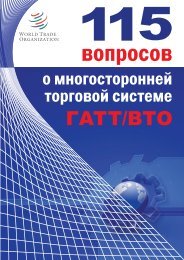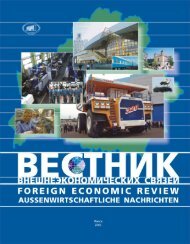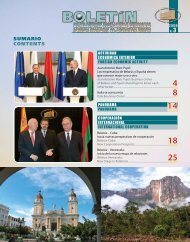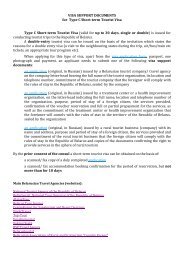Human Development Report 2013 - UNDP
Human Development Report 2013 - UNDP
Human Development Report 2013 - UNDP
Create successful ePaper yourself
Turn your PDF publications into a flip-book with our unique Google optimized e-Paper software.
Technical appendix:explanatory note for projections exerciseThis technical appendix summarizes the two projection modelsdiscussed in chapter 4.Lutz and KC (<strong>2013</strong>) Model for demography,education and human developmentThe Lutz and KC (<strong>2013</strong>) Model is used to project demographictrends through to 2050. It is based on the premise that trends inpopulation growth are affected by improvements in educationquality and quantity. This <strong>Report</strong> employs a dataset covering120 countries, with their populations disaggregated by age, sexand education level.Lutz and KC’s multistate population modelling approachwas developed in the 1970s at the International Institutefor Applied Systems Analysis in Austria and is well acceptedamong technical demographers. The idea behind the projectionis straightforward: with a baseline year of 2000 (the latest yearfor which internationally comparable data are available formost countries) and assuming that education level remainsinvariant after a certain age, the proportion of women ages50–54 without any formal education in 2005 can be deriveddirectly from the proportion of women ages 45–49 without anyformal education in 2000.Given that the size of a birth cohort as it ages over time canchange only through mortality and migration, these proportionswould be constant only if no individual moved up to theprimary education category after age 15 and if mortality andmigration did not differ by education level. However, stronglinks exist between education level and mortality, fertilityand migration behaviour, so the approach must be adjustedto correct for these effects. The size of a birth cohort dependson the education level of women of childbearing age, where anegative relationship is traditionally observed. In projectingthese cohorts forward, differential survival rates, based on acomprehensive literature review and modelling exercises usingpast data, are applied to the education groups.In reality, the likelihood of an individual transitioning fromone education level to the next highest strongly depends onthe education level of his or her parents. But this educationalinheritance mechanism is not explicitly modelled here. Instead,assumptions regarding transition rates and their future developmentare statistically derived from the aggregate behaviourof education systems in the past. Since this expansion is partlythe result of the inheritance mechanism—the fact that manyparents desire that their children reach an education level atleast as high as their own—inheritance is implicitly reflectedin the projection, even though it is not formally part of themodel. Such an approach appears preferable because data onthe aggregate growth patterns of education systems, on whichassumptions for the future can be based, are much more readilyavailable than robust data on the microprocess of educationalinheritance.The procedure for each country can be summarized asfollows:• A baseline population distribution by five-year age groupcohorts, sex and education level is derived for 2000.• For each five-year time step, cohorts move to the next fiveyearage group.• Mortality rates specific to each age cohort, sex and educationgroup and to each period are applied.• Age- and sex-specific education transition rates are applied.• Age-, sex- and education-specific net migrants are added to orremoved from the population. In the projections presentedhere the migration assumptions correspond to those used inthe UN population projections.• Fertility rates, specific to each age, sex and education groupand to each period, are applied to determine the size of thenew 0–5 age group.• The new population distribution by age, sex and educationlevel is noted, and the above steps are repeated for the nextfive-year time step.The projection aims to yield a dataset with the populationdistributed by five-year age groups (from ages 15–20 to ages 100and older), by sex, and by four education levels over 50 yearsfrom 2000 (the base year) to 2050 in five-year intervals.Pardee Center for International Futures(<strong>2013</strong>) Model for prospects of humandevelopment and policy scenariosThis <strong>Report</strong> uses the International Futures Model for long-termhuman development projections based on closely interactingpolicy-related issues, including income, health, education, poverty,gender, social change (instability and risk) and environmentalsustainability. For more detailed information on howthe model was developed, see Pardee Center for InternationalFutures (<strong>2013</strong>) and the University of Denver Korbel Schoolwebsite (www.ifs.du.edu/introduction).The International Futures Model is a large-scale, long-term,integrated global modelling system that incorporates demographic,economic, education, health, energy, agricultural,sociopolitical, infrastructural, technological and environmentalsubmodels for 183 countries interacting in the global system.The model was used in the 2011 <strong>Human</strong> <strong>Development</strong> <strong>Report</strong>to project long-term environmental trend scenarios and evaluatetheir impact on human development.200 | HUMAN DevELoPMENt REPort <strong>2013</strong>
















